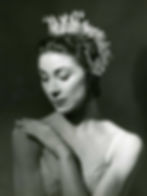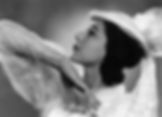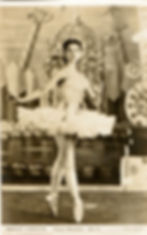Dame Margot Fonteyn: Prima Ballerina of The Royal Ballet
- Chrissy Hamlin
- Dec 19, 2021
- 11 min read

In our festive Christmas Podcast episode, Ballet Dancer & Historian, Jessica Shoroshuck, from Winnipeg, Manitoba, Canada, told us about the incredible life and work of Britain's most celebrated Prima Ballerina's, Dame Margot Fonteyn of the Royal Ballet. In this blog post we delve deeper into her life story, and give links for further reading, and viewing.
Born Margaret Evelyn Hookham, on 18 May 1919 in Surrey, her mother, Hilda Hookam, guided & supported her daughter's career from an early age. Hilda was the illegitimate daughter of a Brazilian industrialist, named Antonio Gonçalves Fontes - which means "Fountain". "Peggy" Hookham changed her name to "Margot Fonteyn" as it sounded far more refined for a professional Ballet Dancer.
Margot's father worked for The British American Tobacco company, and as a result, Margot moved with her parents first to Kentucky, then to Hong Kong & Shanghai in China in the 1930's,whilst she was growing up.

Her mother brought her back to London when she was 14, to pursue a ballet career. In 1934, Margot's father wrote from Shanghai, explaining he had been having an affair. He asked his wife for a divorce so that he could marry his new girlfriend. Continuing to work in Shanghai during WW2, her father was interned from 1943 to 1945 by the invading Japanese. After the war, he returned to England with his second wife, Beatrice.
In the early 1930's, when she was still in her teens, Margot was spotted by Dame Ninette De Valois and was invited to join the Vic - Wells Ballet School, which would later become the Royal Ballet. In 1935, Fonteyn had her solo debut, playing Young Tregennis in The Haunted Ballroom. That same year, Sir Frederick Ashton created the role of the bride in his choreography of Stravinsky's "Le baiser de la fée" specifically for her. When When Alicia Markova, the first Prima Ballerina of the company, left the Vic-Wells later in 1935, Fonteyn shared the lead with other members of the company, but quickly rose to the top of the field of dancers.
Her first professional partnership with Australian Dancer and Choreographer, Sir Robert Helpmann, during the 1930's and 40's, helped to develop her theatricality. Margot Fonteyn also had an on-off personal relationship with the company's musical director, Constant Lambert, at this time.
When Margot went to the University of Cambridge for a professional engagement in 1937, she met Roberto "Tito" Arias. The 18-year-old law student from Panama, would in later years become her husband. Fonteyn became fascinated after watching him perform a rumba dance at a party, and as a consequence, the pair enjoyed spending time together for the week, but Arias then returned to Panama for the summer holidays and afterwards, did not communicate with Fonteyn.

By 1939 Fonteyn had performed the principal roles in Giselle, Swan Lake and The Sleeping Beauty and was appointed as the Prima Ballerina of the renamed Sadler's Wells Ballet. Her performance in Swan Lake had been a turning point in her career, convincing critics and audiences alike, that a British ballerina could successfully dance the lead role in a full-length classical Russian ballet.
Throughout World War Two, Margot danced nightly, sometimes also performing matinées, to entertain troops. With such a heavy schedule, she was frequently obliged to complete three to four times her usual weekly number of appearances. With short London seasons, she also travelled abroad and was in the Netherlands when it was invaded in May 1940, escaping back to England with nothing more than the costume she was wearing. In September 1940, as the London Blitz began, the Sadler's Wells Theatre was turned into an air raid shelter. The company was temporarily displaced, touring professionally across England.
In August 1943, Fonteyn took 2 months unexplained sick leave from the company, missing their opening season performances. Meredith Daneman, her biographer, believes that Margot had an abortion. Fonteyn's relationship with Constant Lambert had grown increasingly difficult, due to his heavy drinking and affairs with other women.

In 1946, the company moved to the Royal Opera House at Covent Garden. One of Fonteyn's first roles was at a command performance of Tchaikovsky's The Sleeping Beauty as Aurora. with King George, Queen Elizabeth, Queen Mary, Princess Elizabeth, Princess Margaret, and Prime Minister Clement Attlee in attendance. The ballet became a signature production for the company and a distinguishing role for Fonteyn, marking her "arrival" as the "brightest crown" of the Sadler's Wells Company. Reprising the role of Aurora in 1949 when the Royal Ballet toured the United States, Fonteyn instantly became a celebrity there too. Fonteyn appeared in America on The Ed Sullivan Show for the first time in 1951 and would return several times. Her performances were credited with improving the popularity of dance with American audiences. Fonteyn was made a Commander of the Order of the British Empire in 1951 for her contributions to British ballet. but plagued by injury, she was thinking about retiring soon.

On another American tour in 1953, Fonteyn became reacquainted with Roberto "Tito" Arias when he surprised her with a visit to her dressing room after a performance of Sleeping Beauty. Arias was now a politician and Panamanian delegate to the United Nations. Although he already had a wife and children, Arias initiated a courtship with Fonteyn and began seeking a divorce from his wife. In Paris on 6 February 1955, Fonteyn married Arias. Shortly before her marriage Fonteyn had been selected to succeed Adeline Genée, as president of the Royal Academy of Dance and though she protested the appointment, the Academy overruled her decision. Fonteyn was made a Dame Commander of the Order of the British Empire in 1956.
Her husband had been appointed an ambassador to the court of St James upon his marriage, so Fonteyn also attended to the duties required of a diplomat's wife. In 1956, she gave four performances in Johannesburg, South Africa, but was criticized for performing, because of apartheid. She was also criticized for performing for Imelda Marcos and was once detained for attending a party at which drugs were used.

In April 1959, Fonteyn was arrested, detained for 24 hours in a Panamanian jail, and then deported to New York City. Her husband had staged a coup d'état against President Ernesto de la Guardia, possibly with the support of Fidel Castro. According to Fonteyn, the plot was hatched when she and her husband were visiting Cuba in January 1959, with Castro promising to assist Arias with arms or men. The couple went fishing on their boat The Nola and during the voyage ordered fishermen to raise a buoy loaded with arms. The fishermen reported the couple, who hurriedly decided that Arias should try to escape detection. In the night Arias jumped ship, boarding the shrimp boat Elaine, while Fonteyn used her own yacht as a decoy to divert the government forces. She returned to Panama City to turn herself in, hoping her surrender would help her husband.
Meeting at the prison with the British ambassador to Panama Sir Ian Henderson, Fonteyn confessed her involvement and the British Foreign Office granted that her statement was confidential. The British embassy arranged for her release, and flew her to New York City on 22 April, without disclosing to the United States government that Cuba had been involved in the plot. Arias took refuge in the Brazilian embassy of Panama and arrived safely in Lima, Peru, the same day Fonteyn arrived in New York.

Fonteyn began her greatest artistic partnership at a time when many people, including the head of the Royal Ballet, Ninette de Valois, thought she was about to retire. In 1961 Rudolf Nureyev, star of the Kirov Ballet, defected in Paris and was invited to join the Royal Ballet. Fonteyn was given the opportunity to dance with him in his debut, but she was reluctant at first because of their 19-year age gap. They went on to make history together. Sir Frederick Ashton choreographed Marguerite and Armand for them, which no other couple danced until the 21st century. Nureyev and Fonteyn were two stars of equal talent who pushed each other to their best performances. It became a signature work for the duo, and sealed their partnership.
In 1964, Fonteyn and Nureyev toured with The Australian Ballet and performed in Stuttgart. On 8 June that year, Margot was told that a Panamanian politician or possibly a jealous husband, had shot Fonteyn's husband Arias, but it was unclear if he was in imminent danger. Fonteyn, though shaken, still danced in MacMillan's Divertimento, on 9 June, before flying home to Panama.
Arias had been shot four times by his lover's husband, Alfredo Jimenez, leaving him a quadriplegic for the rest of his life. Fonteyn forgot about her plans for retirement - she needed to continue working to pay Arias' medical bills. Though he was wheelchair-bound, Fonteyn, was devoted to his well-being, and took him with her on most of her travels. Within two weeks, she had returned to London, having arranged for Arias to be treated at the National Spinal Injuries Centre of the Stoke Mandeville Hospital, and had resumed dancing.

Fonteyn and Nureyev were famed for their performance of classics, such as The Sleeping Beauty and Swan Lake, which Fonteyn stripped to the essence of the roles and constantly improved her performance.
In 1965, the couple debuted the title roles in Romeo and Juliet choreographed by Sir Kenneth MacMillan, who had intended the roles to be performed by Lynn Seymour and Christopher Gable, but David Webster, the manager of the Royal Opera House, insisted on Fonteyn and Nureyev.
A year after the debut, the production was still drawing queues for its nightly performances. The audiences littered the duo with flowers, demanding repeated curtain-calls. Fonteyn's depth as an actor made the performance unique, making Juliet one of her most acclaimed roles.
Despite differences in background and temperament – she was methodical while he was wildly exuberant – and a 19-year gap in their ages, Fonteyn and Nureyev became lifelong friends. Nureyev said that they were lovers, while Fonteyn denied it.
Nureyev said about Fonteyn:
"At the end of 'Lac des Cygnes', when she left the stage in her great white tutu I would have followed her to the end of the world."
In 1965, Fonteyn and Nureyev appeared together in the recorded versions Les Sylphides, and the Le Corsaire Pas de Deux, as part of the documentary An Evening with the Royal Ballet. The film grossed over US$1 million, creating a record for a dance film at the time, and was shown in over 50 theatres in New York and New Jersey alone over the week of 6 December 1965.

Fonteyn went into semi-retirement in 1972, relinquishing parts in full ballets and limiting herself to only a variety of one-act performances.
In 1974, she was awarded the Royal Society of Arts' Benjamin Franklin Medal, in recognition of her having built bridges between Britain and the U.S. through her art.
She also ventured into modern dance, performing as "Desdemona" in José Limón' The Moor's Pavane June 1975 with the Chicago Ballet, followed by a performance of the same dance with Nureyev at The Kennedy Center in Washington, D.C. Between the two performances, Fonteyn was appearing with the Martha Graham Dance Company in Saratoga, New York City, Athens and London. After the performance at The Kennedy Center, her tour went on to Brazil.
In 1976, she published her autobiography, though it was not a tell-all. Her husband was still living and Fonteyn was a very private person, as well as proper and fastidious.

Fonteyn retired in 1979 at the age of 60, 45 years after becoming the Royal Ballet's prima ballerina. For her 60th birthday, Fonteyn was feted by the Royal Ballet, dancing a duet with Sir Frederick Ashton in his Salut d'amour and a tango from Ashton's Façade with her former partner Helpmann. At the end of the evening, she was officially pronounced "prima ballerina assoluta" of the Royal Ballet.
After Margot retired, she went to live on a Panama cattle farm with her husband. The small farmhouse near El Higo, which did not have a telephone, was in a remote village, but she stayed in touch with Nureyev, making telephone calls to him from a neighbour's hotel, several times each week. She told him that she had discovered a real interest in raising cattle and had developed a herd of four hundred head.
In 1979, Fonteyn wrote The Magic of Dance which was aired on the BBC as a television series in which she starred. The six-part BBC2 series, explored aspects in the development of dance from the 17th to the 20th century.
In 1982, she was made chancellor of Durham University, which she accepted as a great honour, considering her limited and frequently interrupted education. Fonteyn also published Pavlova: Portrait of a Dancer, in 1984, as a homage to Anna Pavlova, whom she admired.

In 1989, shortly before the death of her husband, Fonteyn was diagnosed with ovarian cancer. Having used up all her savings to care for Arias, and now retired without a pension, she dreaded the ordeal. Her step-daughter, Querube Arias, cared for her and accompanied her to Houston, Texas on her regular trips to M.D. Anderson Hospital. Nureyev was one of the few people she told of her problems and he arranged to visit her regularly in Houston, despite his busy schedule as a performer and choreographer.
By 1990, she had undergone three operations and was bedridden. Out of money, Fonteyn began to sell her jewelry to pay for her care, and Nureyev anonymously helped to pay the bills. In May, a gala was held at Covent Gardens to raise money for her care. Placido Domingo volunteered to sing and Nureyev danced. The event was attended by more than 2,000 guests, including Princess Margaret, Diana, Princess of Wales, and Dame Ninette de Valois, raising £250,000 for a trust fund to provide for Fonteyn's support.
Before her death, on 21 February 1991, Fonteyn converted to Roman Catholicism so that she could have her ashes buried in the same tomb as Arias, near their home in Panama. A memorial service was held in London on 2 July 1991 at Westminster Abbey. A grief-stricken Nureyev, who was dealing with his own health issues in the form of AIDS, was unable to attend either service.

In Fonteyn's hometown of Reigate, in Surrey, a statue created by British sculptor Nathan David in 1980, stands in tribute to her. Depicting her in her favourite role of "Ondine", the statue was commissioned by fans worldwide.
The main hall in Dunelm House, the Student Union building at the University of Durham, is named the Fonteyn Ballroom in her honour, as is the foyer to the Great Hall of University College, Durham, in Durham Castle.
In 2005, Margot's Closet, a dancing apparel and accessory shop, named in homage to Fonteyn, opened in Marietta, Georgia, an Atlanta suburb. The Margot Fonteyn Academy of Ballet established in Peekskill, New York in 2007 is named in her honour.
In the early 1990s, the fossil plant Williamsonia margotiana was named after Fonteyn and she was one of five "Women of Achievement" selected for a set of British stamps issued in August 1996.
In 2005 Tony Palmer made a documentary for ITV about Fonteyn, titled simply Margot. It includes interviews with several colleagues from the dance world, Nureyev's personal assistant, and Fonteyn's sister-in-law, Phoebe Fonteyn. You can view it below.
The BBC made a film about Fonteyn, which was broadcast in 2009, based on Daneman's biography, and starring Anne-Marie Duff. You can watch the trailer for it below.
In 2016, the English Heritage Trust installed a blue plaque on the building where Fonteyn lived when she was performing with the Sadler's Wells Ballet. To mark the 100th anniversary of her birth, The Theatre and Film Guild installed a commemorative blue plaque to Fonteyn at her childhood home at 3 Elm Grove Road, Ealing.
TELEVISION INTERVIEW WITH MARGOT FONTEYN
WATCH THE FULL LENGTH TONY PALMER ITV DOCUMENTARY FILM "MARGOT" BELOW
TRAILER FOR THE BBC4 DRAMA "MARGOT" STARRING ANN MARIE DUFF AS MARGOT FONTEYN
FURTHER READING AND LINKS
NEWSPAPER ARTICLES ON MARGOT FONTEYN
Margot Fonteyn: 'I've never been a dedicated dancer' – archive, 1970 | Margot Fonteyn | The Guardian























